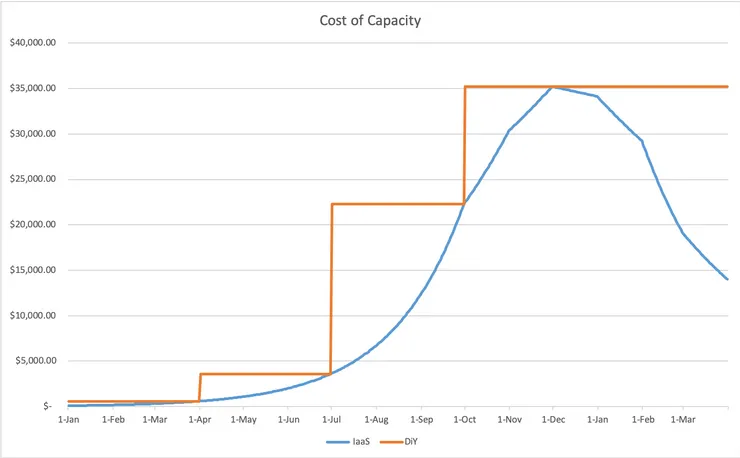We are living in a new age of sustainable thinking. Individuals and businesses are becoming more focused on controlling waste – of all kinds — and working to reduce impact. Whether recycling at home, driving a more efficient car, or working to evolve the process in a company’s supply chain, reducing waste comes in many forms.
When deciding on the right cloud strategy for your business, I hope this point of view on Economic Waste Factors will be helpful as you weigh options.
Waste of Money
Most organizations compare hardware quotes to the monthly cost of a cloud service and try to justify it in the context of a single project and purely based on the cost of a set consumption, maybe including a growth factor but rarely includes a projected decrease over time.
However, planning and deploying yourself creates waste. To illustrate this, the below graph shows a common Compute and Storage consumption scenario and its impact of having to buy ahead.

Note: Assuming a two percent daily growth curve (to emphasize the dynamic). IaaS vs Do it Yourself (DIY) cost is assumed to be equal for the same services and normalized by month to reflect a typical cloud billing cycle. DIY assumes it requires three months to get future capacity ready for end-user consumption including acquisition and payment.
This scenario shows that DIY is 124% of IaaS without the reduced usage at the end of the year. If you include a downturn, DIY goes up to 138% of IaaS solely because of the waste that is created by having to build ahead of the demand.
Waste of Time
There is another challenge inherent to providing infrastructure yourself. For example, an IT organization was asked to investigate what the application performance would be if they were to service Hong Kong from a Singapore datacenter. In a DIY model, it would have taken $100K in hardware, a 12-month lease for a datacenter and at least six to nine months to set it up. Working with an IaaS service provider in Singapore, it took $10K and 30 days to build up the application infrastructure and run real tests. They found out it would NOT work.
Waste of Talent & Resources
As an enterprise, running your own IaaS should be considered carefully. When you can make a long commitment to a workload and/or need a lot of control of the infrastructure, DIY may be the only way to go. However, I believe most organizations grossly underestimate what it takes to provide an IaaS with the availability, performance, security, economics and change aspects the business expects in today’s digital world. And you still must consider having your DIY team deliver the type of releases of new features that IaaS providers bring quarterly nowadays. To do so would require a considerable investment in skills and resources not necessarily critical to your specific business.
While there are valid use cases that require private clouds, I would argue that given the increased business change velocity requirements, investing money, time and resources in designing, deploying and managing your own services creates rarely a competitive advantage. And the level of effort is often underestimated. So be sure to make careful, informed decisions. And avoid the waste.
If you want to learn more about what might be the best strategy for your organization, feel free to reach out.
Author:
